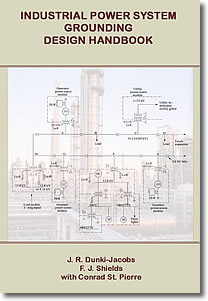|
 |
|
About the Book
Chapter Outline:
Chapter 1. Preparatory notations
Chapter 2. Grounding overview
Chapter 3. Causes and characteristics of neutral instability in ungrounded systems
Chapter 4. The cure for neutral instability
Chapter 5. Fundamentals of neutral-grounded systems
Chapter 6. The inductance effect on ground-fault-circuit loops
Chapter 7. Character of ground faults
Chapter 8. Characteristics of transformers during ground faults
Chapter 9. Grounding power-source neutrals
Chapter 10. System and equipment response to ground faults and harmonics, involving ground
Chapter 11. Ground-fault protection and detection
Chapter 12. Designing industrial power systems from a grounding perspective
Chapter 13. Symmetrical components
The first 11 chapters are preparatory to the ultimate task of designing global industrial systems with optimized grounding and protection attributes, detailed in Chapter 12. Chapter 13 offers a focused synopsis of symmetrical components.
|

|
Objective of the Book
This book's objective is to fill the void in the bibliography on a subject that has received scarce attention. Up until the late fifties, ungrounded neutral systems were prevalent as only three conductors were considered to be essential in operating 3-phase systems. When frequent phase-to-ground machine insulation failures began to afflict such systems, the cause was found to be neutral instability, an inherent characteristic of ungrounded systems.
While the remedial trend towards solidly-grounded neutral systems took its course, serious injury and equipment damage - primarily in 480-V systems - developed due to ground faults. A small task force of engineers, whose employer as the then major electrical equipment manufacturer having a vital interest in solving these incidences, began to research the cause of the phenomenon, which was identified as the arcing-ground fault. Over the time of their professional experience as industrial power system design engineers in Schenectady, NY, two of the authors were privileged to participate in this research that developed and formulated the 3-point remedial thrust of: resistance grounding system neutrals, improved ground-fault protection, and encapsulating energized parts in switching-equipment. These remedies were documented - but only partially and piecemeal - in a number of IEEE papers and IEEE Std. 142 (Green Book).
Industrial Power System Grounding Design Handbook is a comprehensive reference and study guide for the design of global industrial and commercial power systems as dictated by optimized neutral-grounding and ground-fault-protection practices. Except for the noted isolated IEEE references, there are no comparable books currently on the market. In fact, the authors actively contributed to the accrual of the relevant IEEE-paper bibliography.
Benefits for the Reader
This book was written with a dual purpose:
1. As a one-stop reference for budding, as well as practicing electrical engineers/consultants interested in, or responsible for, the design of safe and effective electrical installations for industrial plants.
2. As a text book for a graduate course on industrial and commercial power system design in general, and system grounding and ground-fault protection, in particular.
The reader should find the book self-sufficient as it develops in the first 11 chapters the pertinent preparatory engineering and analytical know-how. In Chapter 12, this collective proficiency will be merged into the formulation of guidelines for the ultimate goal of designing the industrial systems with optimized grounding and protection attributes. Chapter 13 offers a focused synopsis of symmetrical components and a sample of its application.
Considering the reported shrinking base of electrical engineering graduates with a well-developed power background suggests that such engineers would benefit from this comprehensive book; not only as a source of reference but also a study guide for on-the-job training.
What Makes This Book Unique?
Industrial Power System Grounding Design Handbook was authored and published by engineers with life-time experiences as industrial and commercial power system design engineers, who accumulated considerable experience practicing, and teaching the subject. The resulting 584-page manuscript features some 360 detailed illustrations and 19 photographs to facilitate explication.
The scope of this book is not limited to "grounding and ground-fault protection", which is covered in just one of the 13 chapters. Instead, the core subject is the development of an engineering aptitude and rationale to design conceptual industrial and commercial power systems from a grounding perspective; a subject not known to be taught in college, or anywhere else the authors know of. This aptitude is developed only through exposure to comprehensive engineering practices. The appearance of mediocre conceptual designs in contemporary professional papers and journals suggest that the book's subject is in urgent need of revelation to would-be authors, reviewers, and instructors alike.
|
|